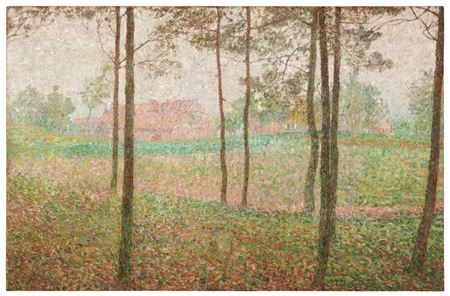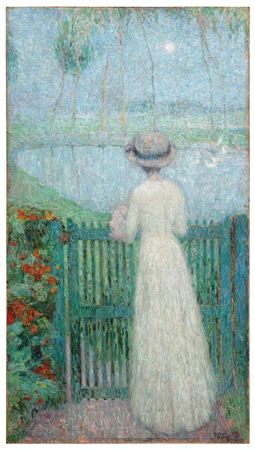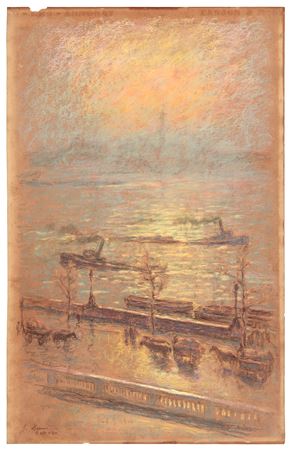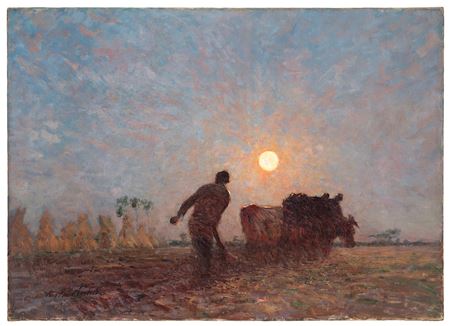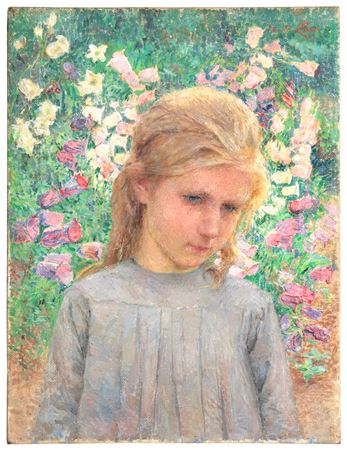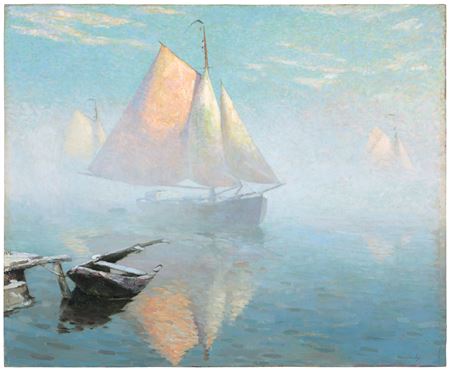At the beginning of the First World War, Claus fled to Great Britain. After a short stay in Wales, he settled in London in the spring of 1915. Initially he starts painting in Kew Gardens, Upton Gray and Hampstead. In his own words, he only discovered a motif for painting at the beginning of 1916, after he had found a space on the fourth floor of the Monbray House, on the corner of Norfolk Street and Embankment, that could serve as a studio. As a source of inspiration Claus mentions the work of William Turner, but this painting is just as well related to the work of Claude Monet and James McNeill Whistler. The influence of Monet is particularly striking due to the fact that both artists found a painting site near Waterloo Bridge. In the article 'The Thames from my Tower Windows', published in The Studio in May 1917, the painter describes the view as follows: "On the left is Blackfriars Bridge, and in the distance on the horizon Tower Bridge; on the right I see Waterloo Bridge and the silhouette of Westminster. These are the views that have varied and enchanting impressions of the river, day after day, in the past few months.
"When Claus writes these rules, his London work takes on a definitive form. The artist has his own reality in mind and seeks a more realistic guidance in the depiction of the busy and noisy life on and around the stream. This Zonseffect on the Thames is one of the best realizations of Claus' series Réverbérations sur la Tamise. The Waterloo Bridge is shrouded in the hazy light of the evening sun. The perspective has been smothered by fog; only vaguely are the contours of the bridge visible to road traffic. The busy activities on and on the banks of the stream have been reduced to nothing at this evening: some vehicles on Embankment, Waterloo Bridge and the Thames are shown in the red evening light. Everything is concentrated around the solar effect on the water that reflects just behind and especially in front of the arches of the bridge, which at the same time puts perspective into the work. The painting is a highly personal impression of the farmer who settled down as a refugee in the metropolis, a city that led him to special impressions for the last time in his career.
Emile Claus
(1849-1924)Sun effect on the Thames
1918Oil on canvas
61 x 50.5 cm (24 x 19 ⁷/₈ inches)
Signed and dated lower left: E. Claus / Londen / 1918
Signed and dated lower left: E. Claus / Londen / 1918
Contact Us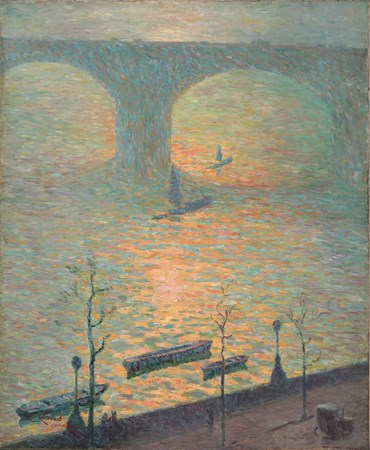
Literature


- Claus, E., "The Thames from my Tower Windows," in: The Studio. An illustrated magazine of fine and applied art, vol 70 (London: The Studio, 1917), p. 169-179.
- De Smet, F., Gand Artistique, no. 4, 1923, p. 85-99.
- Sauton, A., Un Prince du Luminisme Emile Claus (Bruxelles: J. Lebègue & Cie, 1946), p. 54.
- Boyens, P., Sint-Martens-Latem. Kunstenaarsdorp in Vlaanderen (Tielt/ Sint-Martens-Latem: Lannoo/ Art Book Company, 1992), p. 540 (ill.).
- De Smet, J., Retrospectief Emile Claus, tent.cat. (Gent: SD&Z, 1997), pp. 56-58, 221.
- De Smet, J., Sint-Martens-Latem en de Kunst aan de Leie (1870-1970) (Tielt/Sint-Martens-Latem: Lannoo/ Art Book Company, 2000), p. 57-81.
- De Smet, J., A. Tomita, A. Yuzuhana e.a., Emile Claus and Belgian Impressionism (Japan: Himeji City Museum of Art, Tokyo Station Gallery, Ishikawa Prefectural Museum of Art & Hekinan City Tatsukichi Fujii Museum of Contemporary Art, 2013), p. 72-73, no. 26 (ill.).
- Pauwels, P.J.H., Als een fonkelenden spiegel (Sint-Martens-Latem: Galerie Oscar De Vos, 2019), p. 169 (ill.).
- De Smet, F., Gand Artistique, no. 4, 1923, p. 85-99.
- Sauton, A., Un Prince du Luminisme Emile Claus (Bruxelles: J. Lebègue & Cie, 1946), p. 54.
- Boyens, P., Sint-Martens-Latem. Kunstenaarsdorp in Vlaanderen (Tielt/ Sint-Martens-Latem: Lannoo/ Art Book Company, 1992), p. 540 (ill.).
- De Smet, J., Retrospectief Emile Claus, tent.cat. (Gent: SD&Z, 1997), pp. 56-58, 221.
- De Smet, J., Sint-Martens-Latem en de Kunst aan de Leie (1870-1970) (Tielt/Sint-Martens-Latem: Lannoo/ Art Book Company, 2000), p. 57-81.
- De Smet, J., A. Tomita, A. Yuzuhana e.a., Emile Claus and Belgian Impressionism (Japan: Himeji City Museum of Art, Tokyo Station Gallery, Ishikawa Prefectural Museum of Art & Hekinan City Tatsukichi Fujii Museum of Contemporary Art, 2013), p. 72-73, no. 26 (ill.).
- Pauwels, P.J.H., Als een fonkelenden spiegel (Sint-Martens-Latem: Galerie Oscar De Vos, 2019), p. 169 (ill.).
Description


You May Also Like




